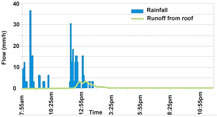

home > green roofs > benefits
Biodiversity
Green roofs have considerable potential to provide biodiversity benefits and specifically to support the delivery of national, regional and local biodiversity action plans.
Plants – a wide range of plants can be grown on green roofs, including mosses and ferns, herbaceous perennials, annuals, grasses, bulbs and trees and shrubs. |
In urban areas there is particular interest in the use of green roofs as mitigation for the loss of brownfield sites, which often provide extremely valuable wildlife habitat. The English Nature report Green roofs: their existing status and potential for conserving biodiversity in urban areas (Grant et al, 2003), highlights a number of ways in which green roofs can contribute. These include:
The use of green roofs as mitigation for the loss of ground level habitat can present number of challenges and consequently it is important to seek specialist ecological input where the green roof is required to meet specific biodiversity objectives. Key considerations include:
Sustainable Drainage
Green roofs are ideal components of sustainable drainage systems (SUDS) and can make a valuable contribution to mitigating the adverse effects of development on rainfall runoff.
A fundamental concept of SUDS is the use of source control, i.e. the control of run-off at or very near its source. Green roofs can contribute to source control objectives through:
Research in the UK (Kellagher and Lauchlan, 2005, CIRIA, 2007) indicates that green roofs are effective in providing both attenuation and volume reduction in runoff for small events, and suggests that these advantages are reduced but not lost for larger events.
The green roof influences the runoff hydrograph in two ways:

1. Interception and retention of rainfall from the early part of a storm
2. Limiting the maximum release rate of runoff in larger storms
The performance of a green roof will depend on the depth and type of substrate used and the particular rainfall patterns and season.
In addition to their impact on the volume of run-off from a site, green roofs can also contribute to pollution removal from stormwater run-off by retaining and binding contaminants that are introduced to the surface as dust or suspended/ dissolved in rainwater. Research suggests that 95 per cent of heavy metals can be removed from run-off by green roofs and nitrogen levels can also be reduced (Johnston and Newton, 2004). Careful attention should be paid to the materials to be used in the green roof construction, especially where they have been reclaimed, to ensure that pollutants don’t leach out of the green roof substrate.
Climate change mitigation and adaptation
As the impacts of human activities on the global climate are becoming better and more widely understood increasing attention is being paid to the need to mitigate for climate change by taking actions to reduce green house gas emissions, and to adapt to better deal with the consequences of a warming climate.
The use of green roofs has the potential to contribute to both these goals, by improving the thermal performance of buildings - thus reducing energy demand - and by reducing the impact of buildings on the local environment. These contributions can be summarised as follows:
Thermal insulation - the insulating properties of a green roof need to be considered in the context of the overall insulation strategy of the building. For new buildings which meet the energy efficiency requirements of the Building Regulations, 2006 it is unlikely that green roofs or walls will contribute significantly to energy savings. This is because the insulation layer now required largely ensures that the internal thermal performance of the building is isolated from the external environmental conditions. However, for older, lightweight, and poorly insulated buildings green roofs can be effective at providing insulation and thermal mass.
Reduction of daily temperature fluctuations - the diurnal temperature range of a conventionally constructed warm roof can be very large e.g. 25oC on a summer’s day. In contrast, the diurnal temperature range at the waterproof layer of an extensive green roof during summer is typically less than 10oC. A number of factors contribute to this, including evapotranspiration from plants, the larger thermal mass of the green roof and the higher equivalent albedo of plants. The reduction in diurnal temperature range can reduce impacts on the internal building environment and limit the impact of the roof on the local microclimate.
Mitigation of the urban heat island effect – the higher equivalent albedo of a green roof, compared to a conventional roof, and the impact of the evaporative cooling from a green roof, could if sufficiently widely implemented contribute towards reducing the urban heat island effect. In a warming climate this impact could become increasingly important.
Reference
Woods-Ballard, B, Kellagher, R, Martin, P, Jefferies, C, Bray, R, Shaffer, P (2007)
The SUDS manual
CIRIA C697 (ISBN: 978-0-86017-697-8)
Grant, G, Engleback, L and Nicholson, B (2003)
Green roofs: their existing status and potential for conserving biodiversity in urban areas
English Nature Research Report. Report No 498 (www.english-nature.co.uk/news/news_photo/Greenroofs.pdf)
Johnston, J and Newton, J (2004)
Building Green, a guide to using plants on roofs, walls and pavements
Greater London Authority, May 2004 (ISBN: 1-85261-637-7)
Kellagher, R and Lauchlan, C, S (2005)
Use of SUDS in high density developments, Guidance Manual
HR Wallingford Report SR666, Release 3.0, June 2005